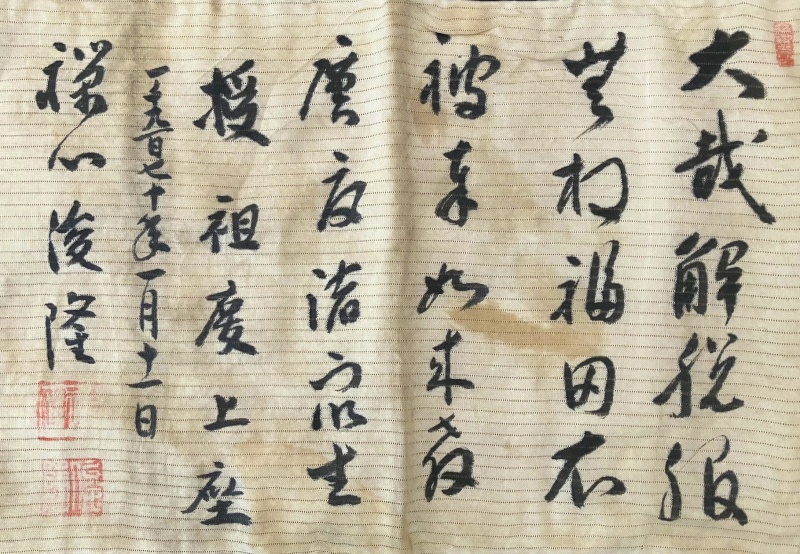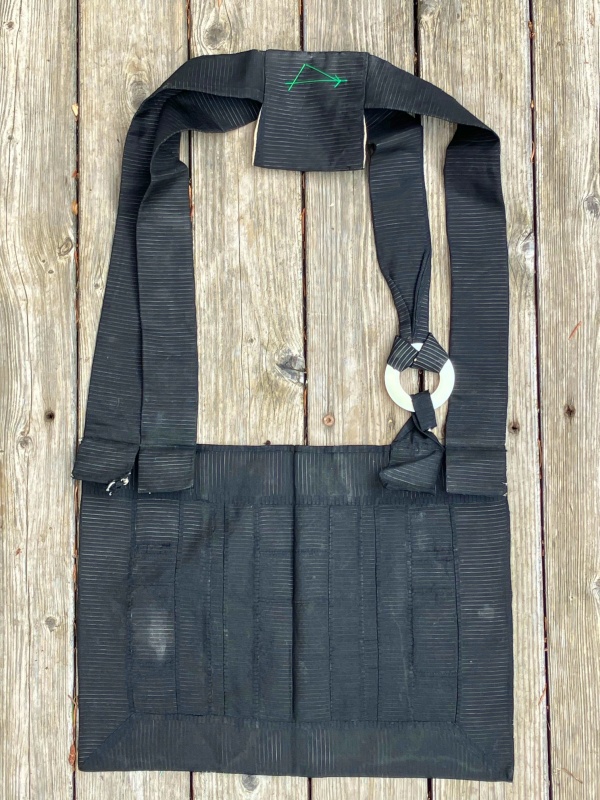Letters and Calligraphy | Graphics
Silas Hoadley’s Rakusu

This translation is based on consultation with Shungo Suzuki and Bill Porter.
First four lines the robe chant
Then the first character means to bestow followed by Silas’s Buddhist name.
Sokei Joza - Celebrated Ancestor, Exhaulted Rank (high seat) (Amber recalled hearing "Auspicious Ancestor." Maybe Suzuki said that but we don’t know. Celebrated is more literal. Bill Porter likes Jubilant.)
January 11, 1970
Zenshin Shunryu
****
大哉解脱服
無相福田衣
被奉如来教
廣度諸衆生
授 祖慶上座
一千九百七十年 一月十一日
禅心俊隆
Robe chant - Takkesa Ge
Dai sai geda puku
Muso fukuden e
Hi bu nyorai kyo
Kodo sho shu jo
Great robe of liberation
Field far beyond form & emptiness
Wearing the Tathagata’s teaching
Saving all beings
(Shunryu Suzuki’s translation - what we used at ZC)
Robe of Liberation boundless
Field beyond both form and formless
Wearing the Tathagatas Teachings
Vowing to save (free) all sentient beings
(Tree Leaf Zendo - more literal)

Silasís Name Interpretation
According to Shungo Suzuki and Bill Porter Sokei is Silas’s name, the first two kanji in this case, and the Joza is the rank.
Shungo wrote:
Joza is the rank of one who has received Tokudo. It is the rank one holds before undergoing Shuso training. After completing Shuso training one becomes known as Zagen. After performing Shiho (Daruma Transmission) and Zuise one becomes Osho or Rikisho. After performing Shiho (Daruma Transmission) and Zuise one becomes Osho or Rikisho.
From Bill Porter:
So, 祖慶 is pronounced Sokei and was meant for Silas as his personal name. The first character refers to an ancestor but also to a particular kind of ancestor, namely, a patriarch or head of a lineage. The second character, in Chinese, has never meant "auspicious," but "celebration" or "celebrated." Wiktionary gives its meaning, in Japanese, as "jubilation" or "jubilant," depending on grammatical usage. The second set of characters, 上座 (high seat), Joza, is an honorific, something like "teacher," someone who sits in a chair rather than on the floor.
DCís comment:
So Bill Porter and Shungo Suzuki say Silasís name is Sokei and the joza after it is his rank though Shungo points out it indicates tokudo ordination only, a novice monk, and Bill sees it in Chinese terms as a teacher of high rank. It still seems like his 2nd name to me because we all received two names. When Suzuki gave us Buddhist names, he underlined or indicated the main one or the one to use. So maybe thatís the name and the other is the full name or more like a comment. For more on names see the list on the Disciples page.